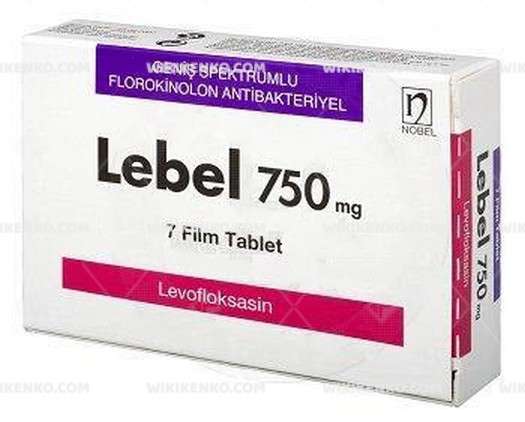Description
Lebel takes the spotlight as a formidable pharmaceutical agent, harnessing the power of levofloxacin, a synthetic, broad-spectrum antibacterial marvel belonging to the fluoroquinolone family of antibiotics.
Applications
Lebel emerges as a beacon of hope in the treatment of a range of infections, including those affecting the:
1. Respiratory System
Lebel is a stalwart defender against respiratory infections, effectively combating community-acquired pneumonia, hospital-acquired pneumonia, and acute exacerbation of chronic bronchitis.
2. Sinuses
It proves its mettle in addressing acute bacterial sinusitis, offering relief from the discomfort of sinus inflammation.
3. Urinary Tract
Lebel tackles urinary tract infections with precision, handling both complicated and uncomplicated cases, including chronic bacterial prostatitis and acute pyelonephritis.
4. Skin and Soft Tissues
In the realm of dermatological health, Lebel extends its capabilities to treat complicated and uncomplicated skin and soft tissue infections.
5. Specialized Protection
Lebel serves a unique role in post-exposure protection, specifically in cases of inhalational anthrax.
Contraindications
Before embracing Lebel as a treatment option, it is paramount to consider contraindications, ensuring safe usage. It should not be used if:
- Allergic reactions have been experienced with levofloxacin or related fluoroquinolone antibiotics.
- Previous tendon issues have arisen during fluoroquinolone antibiotic usage.
- A history of seizures exists.
- Tendon inflammation or pain occurs during its treatment.
- Severe, persistent, and/or bloody diarrhea arises during or after lebel treatment.
- Pregnancy is suspected, confirmed, or planned.
- Breastfeeding is ongoing.
Side Effects
Lebel, like many pharmaceuticals, is not without potential side effects. These may include:
- Tendon inflammation (tendinitis) and tendon rupture.
- Peripheral neuropathy, causing nerve damage.
- Central nervous system effects such as hallucinations, anxiety, depression, suicidal thoughts, insomnia, severe headaches, and confusion.
- Worsening of myasthenia gravis, a condition characterized by muscle weakness.
Any occurrence of these side effects during Lebel treatment warrants immediate cessation of the medication, with avoidance of further fluoroquinolone antibiotic use.
Precautions
The use of fluoroquinolone antibiotics, including Lebel, requires caution. They should only be considered for uncomplicated urinary tract infections, acute bacterial sinusitis, or acute bacterial exacerbation of chronic bronchitis when no alternative treatments are available.
Duration of Lebel Treatment
The duration of Lebel treatment depends on the type and severity of the infection. It is imperative to follow healthcare provider instructions diligently and complete the entire prescribed course of treatment. Premature discontinuation may result in the infection’s resurgence. Any inquiries regarding the treatment’s duration should be directed to your healthcare provider.
Interactions with Foods and Medications
Lebel’s interactions with foods and medications are noteworthy:
Food Interactions
- Levofloxacin oral liquid should be taken either one hour before or two hours after eating. Levofloxacin tablets, however, can be taken with or without meals. A full glass (8 ounces) of water should accompany the medicine. Additional water intake is encouraged daily unless otherwise advised by a healthcare provider.
Drug Interactions
- Levofloxacin may interact with specific medications, including antacids containing magnesium or aluminum (such as Maalox, Mylanta, or Rolaids), the ulcer medication sucralfate (Carafate), didanosine (Videx) in powder or chewable tablet form, and vitamin or mineral supplements containing aluminum, iron, magnesium, or zinc. These interactions may impede levofloxacin’s efficacy. Such medications should be administered at least two hours before or after levofloxacin use.
Driving and Machinery Operation
Lebel contains levofloxacin, which can induce side effects such as dizziness, drowsiness, and visual disturbances. These effects may compromise the ability to operate vehicles or machinery safely. If such side effects manifest while taking it, refraining from these activities is advised. Consultation with a healthcare provider is recommended before resuming these activities during medication use.
Levofloxacin’s Mode of Action
Levofloxacin, a remarkable antibiotic within the fluoroquinolone family, exerts its therapeutic influence by inhibiting two critical bacterial enzymes: topoisomerase IV and DNA gyrase. These enzymes play vital roles in bacterial DNA synthesis and repair. Levofloxacin’s action effectively converts them into toxic enzymes, disrupting DNA processes and ultimately leading to bacterial demise.
Side Effects
In the event of side effects during Lebel treatment, particularly those linked to levofloxacin, prompt contact with a healthcare provider is essential. Some side effects may necessitate medical intervention, and your healthcare provider will offer the most suitable course of action. Reporting side effects ensures the delivery of optimal care throughout your treatment with this medication.
Conclusion
In the realm of pharmaceuticals, Lebel, with its active ingredient levofloxacin, emerges as a stalwart defender against a spectrum of infections. Its therapeutic potential is undeniable, but its usage demands vigilance. Awareness of contraindications, potential side effects, precautions, and interactions is paramount. Through responsible and informed usage, it can continue to serve as a beacon of hope in the ongoing battle against infections.













Reviews
There are no reviews yet.